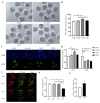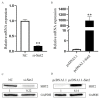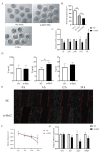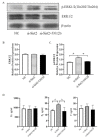SIRT2 Is Critical for Sheep Oocyte Maturation through Regulating Function of Surrounding Granulosa Cells
- PMID: 35563403
- PMCID: PMC9104768
- DOI: 10.3390/ijms23095013
SIRT2 Is Critical for Sheep Oocyte Maturation through Regulating Function of Surrounding Granulosa Cells
Abstract
Oocyte in vitro maturation is crucial for in vitro embryo production technology, which provides oocytes resources for in vitro fertilization and somatic cell nuclear transfer. Previous studies proved that SIRT2, a member of the sirtuin family, plays a role in oocyte meiosis, but its role in sheep oocyte maturation and its regulating mechanism remains unknown. Firstly, we confirmed the role of Sirt2 in sheep oocytes maturation by supplementation of SIRT2 inhibitor and activator. To further explore the specific mechanism, we performed knockdown of Sirt2 in granulosa cells and then cocultured them with oocytes. Moreover, we determined the effects of Sirt2 on granulosa cell oxidative apoptosis, cell migration, and diffusion, and examined its effects on granulosa cell mitochondrial function, mitophagy, and steroid hormone levels. The results showed that supplementation of SIRT2 inhibitor decreased the oocytes maturation rate (69.28% ± 1.28 vs. 45.74% ± 4.74, p < 0.05), while resveratrol, a SIRT2 activator, increased its maturation rate (67.44% ± 1.68 vs. 78.52 ± 1.28, p < 0.05). Knockdown of Sirt2 in sheep granulosa cells also reduced the oocytes maturation rate (47.98% ± 1.43 vs. 33.60% ± 1.77, p < 0.05), and led to decreased cell migration and expansion ability, oxidative apoptosis, abnormal mitochondrial gene expression, decreased mitochondrial membrane potential and ATP level, and increased mitophagy level. Overexpression of Sirt2 improved mitochondrial membrane potential and ATP level and improved mitochondrial function. Furthermore, we found that Sirt2 knockdown in granulosa cells promotes the secretion of P4 through regulating p-ERK1/2. In conclusion the present study showed that SIRT2 is critical for sheep oocyte maturation through regulating the function of ovarian granulosa cells, especially affecting its mitochondrial function.
Keywords: SIRT2; mitochondria; mitophagy; oocytes in vitro maturation; sheep granulosa cells.
Conflict of interest statement
The authors declare no conflict of interest.
Figures










Similar articles
-
SIRT2 regulates apoptosis by inducing mitophagy in sheep cumulus cells.Theriogenology. 2024 Apr 1;218:163-173. doi: 10.1016/j.theriogenology.2024.02.004. Epub 2024 Feb 3. Theriogenology. 2024. PMID: 38330860
-
SIRT2 Inhibition Results in Meiotic Arrest, Mitochondrial Dysfunction, and Disturbance of Redox Homeostasis during Bovine Oocyte Maturation.Int J Mol Sci. 2019 Mar 18;20(6):1365. doi: 10.3390/ijms20061365. Int J Mol Sci. 2019. PMID: 30889926 Free PMC article.
-
Resveratrol improves the quality of pig oocytes derived from early antral follicles through sirtuin 1 activation.Theriogenology. 2015 May;83(8):1360-7. doi: 10.1016/j.theriogenology.2015.01.029. Epub 2015 Feb 4. Theriogenology. 2015. PMID: 25724287
-
Effect of mitophagy in oocytes and granulosa cells on oocyte quality†.Biol Reprod. 2021 Feb 11;104(2):294-304. doi: 10.1093/biolre/ioaa194. Biol Reprod. 2021. PMID: 33079172 Review.
-
[The role of EGF-like factor signaling pathway in granulosa cells in regulation of oocyte maturation and development].Yi Chuan. 2019 Feb 20;41(2):137-145. doi: 10.16288/j.yczz.18-193. Yi Chuan. 2019. PMID: 30803944 Review. Chinese.
Cited by
-
Mitochondrial Quality Control in Ovarian Function: From Mechanisms to Therapeutic Strategies.Reprod Sci. 2025 May;32(5):1399-1413. doi: 10.1007/s43032-024-01634-4. Epub 2024 Jul 9. Reprod Sci. 2025. PMID: 38981995 Review.
-
Mitochondrial Quality Control in Bovine Oocyte Maturation: Mechanisms, Challenges, and Prospects for Enhancing Reproductive Efficiency.Animals (Basel). 2025 Jul 7;15(13):2000. doi: 10.3390/ani15132000. Animals (Basel). 2025. PMID: 40646899 Free PMC article. Review.
-
Hesperidin ameliorates H2O2-induced bovine mammary epithelial cell oxidative stress via the Nrf2 signaling pathway.J Anim Sci Biotechnol. 2024 Apr 9;15(1):57. doi: 10.1186/s40104-024-01012-9. J Anim Sci Biotechnol. 2024. PMID: 38589950 Free PMC article.
-
MiR-134-3p targets HMOX1 to inhibit ferroptosis in granulosa cells of sheep follicles.J Ovarian Res. 2024 Jan 2;17(1):3. doi: 10.1186/s13048-023-01328-6. J Ovarian Res. 2024. PMID: 38166987 Free PMC article.
-
Oocyte transcriptomes and follicular fluid proteomics of ovine atretic follicles reveal the underlying mechanisms of oocyte degeneration.BMC Genomics. 2025 Feb 1;26(1):97. doi: 10.1186/s12864-025-11291-9. BMC Genomics. 2025. PMID: 39893388 Free PMC article.
References
-
- Li H.J., Sutton-McDowall M.L., Wang X., Sugimura S., Thompson J.G., Gilchrist R.B. Extending prematuration with cAMP modulators enhances the cumulus contribution to oocyte antioxidant defence and oocyte quality via gap junctions. Hum. Reprod. 2016;31:810–821. doi: 10.1093/humrep/dew020. - DOI - PubMed
MeSH terms
Substances
Grants and funding
- 2021YFD1200401/National Key R&D Program of China
- C2019204260/Natural Science Foundation of Hebei Province of China
- ZD2020108/Key Project of Educational Commission of Hebei Province of China
- YJ2021013/Special Project for Talents Enrollment of Hebei Agricultural University
- KY2021006/Basic Research Funds for Colleges of Hebei province
LinkOut - more resources
Full Text Sources
Miscellaneous

